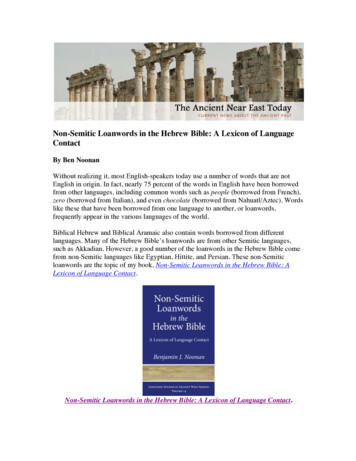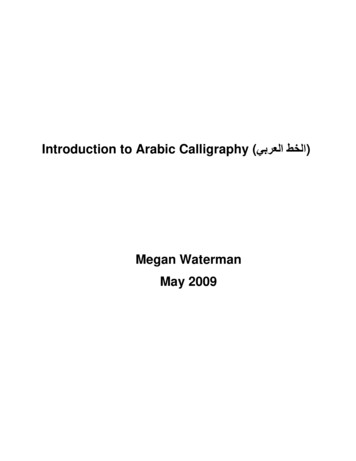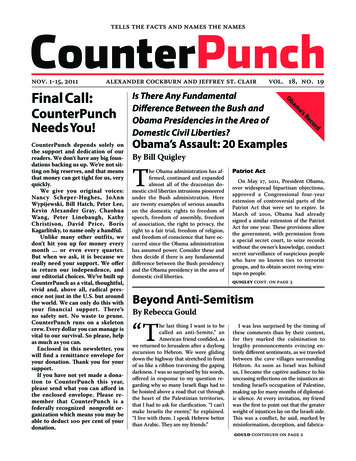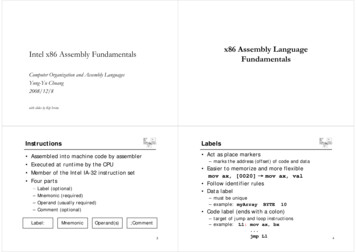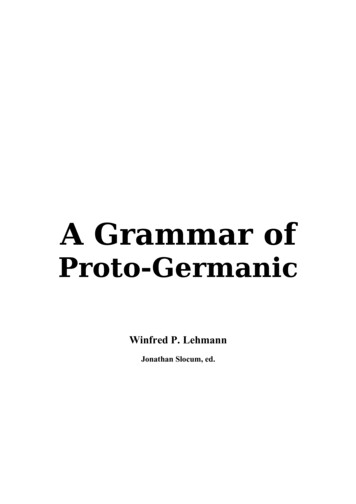
Transcription
ALPHABET, HEBREW.FOR ALL REFERENCES TO “FIGURE” IN THIS ENTRY, PLEASE CONSULT THE PRINTEDEDITION OF THE ENCYCLOPAEDIA JUDAICA.The origin of alphabetic script has always been a subject of human curiosity. According to Greekmythology, script was brought to Greece from Phoenicia. This tradition was accepted by theGreek and Roman writers, some of whom developed it even further, and stated that thePhoenicians learned the art of writing from the Egyptians. In the 19th century there were scholarswho subscribed to the theory of the Egyptian origin, while others believed that the Phoenicianscript developed from the Akkadian cuneiform, Cretan linear, Cypriote syllabic, and Hittitehieroglyphic scripts.NORTH-WEST SEMITICThe Proto-Canaanite and Cuneiform Canaanite ScriptsModern investigation into the origin of the alphabet began in 1905 with the discovery of the ProtoSinaitic inscriptions by Sir Flinders Petrie at Sarabit al-Khadim in the Sinai Peninsula. These wereshort texts inscribed in an unknown pictographic script of approximately the middle of the secondmillennium B.C.E. The first steps toward decipherment of these texts were taken 12 years later bySir Alan Gardiner, who noted a recurrent series—oxgoad ( Canaanite lamd); house ( bayt); Eye( ayn); oxgoad ( lamd); cross ( taw)—and realized that if the signs followed an acrophonicprinciple, their parallel Canaanite value (lamd-bayt-ayn-lamd-taw) would be lblt—"for the lady"(goddess). Since then many attempts at decipherment have been made. The most eminent studyis that of W. F. Albright, who believes that it is possible to identify 23 of the probable 27 lettersoccurring in these texts. Accepting Gardiner's Canaanite acrophonic theory and assuming thatthese texts are votive inscriptions written by West Semites who were employed by the Egyptiansin the turquoise mines of Sarabit al-Khadim, Albright bases his readings on the recent knowledgeof the Canaanite dialects (mainly Ugaritic) in the second millennium B.C.E.AN EARLY PALESTINIAN EPIGRAPHIC CORPUSFor several decades it was assumed that these West Semite workers (or slaves), while being indaily contact with the Egyptian hieroglyphs, invented the first alphabetic writing. However, atsome sites in Palestine several similar pictographic inscriptions were found. Most of them are of alater date than the Proto-Sinaitic texts (mainly from Lachish, but also from Ha\i, Tell el-Amarna,Beth Shemesh, Megiddo), but at least three are earlier than the Proto-Sinaitic inscriptions (fromShechem, Gezer, and Lachish). This early Palestinian epigraphic corpus consists mainly ofinscribed shards and jar inscriptions (partly fragmentary), but there are also inscriptions on seals,a dagger, and javelin heads. The latest specimens (from the end of the Late Bronze period andfrom the very beginning of the Iron age) display simplified linear letter forms which developedfrom the early pictographs. The script of these texts is called Proto-Canaanite. (See Chart:Hebrew Alphabet).The order of the early alphabetic texts is suggested by F. M. Cross, Jr. as follows:I. The Proto-Canaanite Texts a. Old Palestinian (17th–12th century B.C.E.) b. Proto-Sinaitic (15thcentury B.C.E.)II. Canaanite Cuneiform Texts a. Ugaritic (14th–13th century B.C.E.) b. Palestinian (13th–12thcentury B.C.E.)PROTO-CANAANITE SCRIPT AS THE SOURCE OF LATER ALPHABETSThe Proto-Canaanite alphabet seems to copy some pictographic signs from the Egyptianhieroglyphs. Some Canaanite communities adapted the method of writing as in the Akkadiancuneiform syllabic script (i.e., clay tablet and stylus) to the new alphabetic system. Akkadiancuneiform was used in the latter half of the second millennium for international correspondenceeven between the Egyptian pharaoh and his vassals in Palestine (see el-Amarna). The cuneiformalphabet was not limited to Ugarit in northern Canaan; specimens of this script were found atthree sites in Palestine (Beth-Shemesh, Taanach, and Nahal Tabor). However, whereas the
cuneiform alphabet, as far as is known, ceased to exist with the beginning of the Iron Age (12thcentury B.C.E.), the Proto-Canaanite script was the source of all alphabetic scripts which laterspread throughout the entire world. From this script the Proto-Arabic script branched off in thecourse of the 13th century B.C.E. (This is the parent script of the South Arabic monumental andthe Ethiopic script, as well as the Thamudic, Safaitic, and Lihyanic scripts.) The main offshoot ofthe Proto-Canaanite script, however, is the Phoenician, from which the (Ancient) Hebrew andAramaic as well as the Greek alphabets evolved (figure 2).THE TERM "ALPHABETIC SCRIPT"It has been alleged that the term "alphabetic" does not fit West Semitic writing. This script, usingletters for consonantal phonemes (i.e., each sign represents a consonant plus any vowel (or"zero" vowel)) is, in I. J. Gelb's opinion a system of syllabic writing. While it is true that the WestSemitic system of writing is a less developed stage than the Greek, the term alphabet itself doesnot mean that each letter must stand for either a consonant or a vowel, or for a consonant plusany vowel. Alphabet means a number of letters (20 or 30 approximately) listed in a fixed order,notwithstanding their found in Ugarit, belongs to the 14th century B.C.E., and its order (afteromitting some letters) generally fits that of the Hebrew alphabet (figure 3). The reduction of thesymbols to individual values. The first abecedary known until now, represent consonantalphonemes was a revolutionary step toward spreading literacy, and the systematic insertion of thevowel signs into the script was only a further, though important, step in this process. Thereforethere is no reason to restrict the term alphabet to Greek or Latin scripts.The Phoenician ScriptThe Proto-Canaanite and the cuneiform alphabetic (as well as the South Arabic and theClassical, or North Arabic) scripts have 27–30 letters; the cuneiform also distinguishes betweenalef—a, alef—i, and alef—u. The Proto-Canaanite inscriptions were written either in verticalcolumns, in horizontal lines or, quite frequently, in boustrophedon. In the 11th century B.C.E., withthe development of the linear letter forms, the stabilization of the right-to-left direction and thereduction of the number of letters to 22 consonants, the Proto-Canaanite developed into thePhoenician script. (The c. 1000 B.C.E. inscription on the Ahiram sarcophagus found at Byblosdisplays this stage of evolution.) It seems likely that the Phoenician phonemic system consistedof 22 consonants; but the phonemic systems of the Hebrew and Aramaic languages were richerthan that of the Phoenician language. When the Hebrews and Arameans adopted the Phoenicianscript they could not express in writing these phonemes which did not occur in Phoenician. InHebrew, for example, there exists 2 (shin) and c (sin), but both phonemes are designated by thesame letter S; only in a relatively late period, with the invention of the diacritic signs, was itpossible to distinguish between Q (shin) and R (sin).The Phoenician people traded throughout the ancient world, and Phoenician inscriptions havebeen found as far apart as at Ur in the Persian Gulf and in Spain (figure 4). Most of theseinscriptions, however, originated in Phoenicia, Cyprus, and Carthage. The Carthaginianinscriptions and those which were found in the western Phoenician colonies are called Punicinscriptions. While it is possible to distinguish between the dialects which were spoken inPhoenicia proper, in Cyprus, and in the Punic colonies, no special local characteristics in thescripts of the various centers developed. This one-trend evolution seems to be reflected in thescarce ink-written cursive material, but it is especially obvious in the many monumental (mainlyvotive) inscriptions. Whereas the Phoenician inscriptions of eastern origin after the third centuryB.C.E. are rare, the number of the Punic inscriptions (mainly from Carthage) increases in the latethird and early second centuries until the destruction of Carthage in 146 B.C.E. It seems likelythat in this period there developed in the west an independent cursive, which was later adapted tomonumental writing by the neo-Punic communities existing in North Africa after 146 B.C.E. This isthe neo-Punic script.The Hebrew ScriptThe Hebrews adopted the alphabetic script together with other cultural values from theCanaanites in the 12th or 11th century B.C.E. They followed the current Phoenician script untilthe ninth century, when they began to develop their own national script.
EARLY INSCRIPTIONSThe Gezer Calendar is considered to be the earliest Hebrew inscription known. Its scriptresembles the scripts of the tenth century Phoenician inscriptions from Byblos. The spelling oftwo words reflects the contraction of the diphthong ay, which is either a Phoenician or a NorthHebrew (cf. Samaria ostraca) linguistic feature. On paleographical grounds, the Gezer Calendarshould be dated in the late tenth century B.C.E. (i.e., in the time of Solomon) when Gezer was anIsraelite city (I Kings 9:16), and thereby determined as a Hebrew inscription (figure 5).As strange as it may seem, the earliest clear Hebrew features can be discerned in the scripts ofthe ninth-century Moabite inscriptions, namely the stele of Mesha (the Moabite Stone) and in arecently found fragmentary stele where k m2yt, the name of Mesha's father, is mentioned (for theMoabite script, see below).As the eighth-century Hebrew inscriptions exhibit many specific and exclusive traits, it is obviousthat in the ninth century the Hebrew script was written by wide scribal circles. The fact that up tothe present almost no Hebrew inscriptions have been found from the ninth century is accidental,but the quantity of the epigraphic material from the eighth century onward shows a gradualincrease of the spread of the knowledge of writing among the people of Israel and Judah.DEVELOPMENT OF THE INDEPENDENT HEBREW SCRIPTThe evolution of the independent Hebrew script is one of a specific cursive character: the furtherit diverges from the (Phoenician) mother script, the more it drops the lapidary features. This onetrend development is obvious in the eighth-century engraved inscriptions, namely the SiloamInscription, the Royal Steward (figure 6), and other tomb inscriptions (all from Jerusalem), as wellas from the fragmentary Hebrew inscription on an ivory which was taken as booty (probably fromSamaria) to Nimrud, and the hundreds of the eighth to the sixth-century Hebrew seals fromvarious sites. These inscriptions on hard material were written in a cursive style, copying even theshading, which is a natural feature of pen-and-ink writing. This lack of lapidary script may indicatethat the custom of erecting stelae by the kings and offering votive inscriptions to the deity was notwidespread in Israel. Such an assumption would explain how the specific lapidary element coulddisappear from the Hebrew script.HEBREW EPIGRAPHIC MATERIALSThere is some indication of the common use of papyrus. In addition to the seventh-centurypalimpsest papyrus, preserved in the dry climate of Wadi Murabbaat near the Dead Sea about 20clay sealings of papyrus rolls have been found (mostly in Lachish).The majority of the Hebrew epigraphic material which has been found is pottery. About 100 jarinscriptions are known today. Sixty jar handles, inscribed after firing, were found in Gibeon, andother jars bear inscriptions on their bodies. Some were incised or written in ink after firing, butothers were inscribed before firing the vessels. These inscriptions are mainly the names of theowners or the names of those responsible for their capacity, and others indicate the measure ofcapacity (bt lmlk , "a royal bat"). Toward the end of the seventh century B.C.E. it became moreusual to impress a seal on the jar handle rather than to write on the soft clay. Recently 80"private" seal impressions of some 30 specimens and about 800 royal (lmlk) seals were listed (M.L. Heltzer, in: Epigrafika Vostoka, 17 (1965), 18–37).The most important Hebrew epigraphic material consists, of course, of ostraca, some of whichwere incised (e.g., two dockets from Tell Qasile, a name-list and a message-like short letter fromSamaria), but most were written in ink. The majority of ostraca were found in Samaria, Lachish,and Arad. This corpus, together with the Siloam Inscription and an ostracon from MezadHashavyahu, are the most important sources for the study of the Hebrew language in the periodof the First Temple.SOURCES FOR THE HEBREW LANGUAGE IN THE FIRST TEMPLE PERIODThe Samaria ostraca consist of 63 dockets belonging to the eighth century B.C.E., probably to thetime of Jeroboam II. They were found in the storage rooms of the royal palace and describeshipments of wine and oil brought in by farmers from various places, presumably as taxes. This
material is the main source for the study of the Hebrew dialect spoken in the Northern Kingdom,while the other material reflects the Judahite, or Jerusalemite, dialect.The Siloam Inscription describes the building of the tunnel through which the water of the Gihonwas brought into the city of Jerusalem, presumably in the time of Hezekiah (II Kings 20:20; IIChron. 32:30).The ostracon found at the seashore fortress called today Mezad Hashavyahu, near Yavneh Yam(Minat Rubin), is a letter written by a reaper who worked in the royal estate of Josiah, king ofJudah. The reaper complained to the local governor of the confiscation of his garment (cf. Ex.22:25–27; Deut. 24:10–13).The Arad ostraca, which have only been partly published, were found in various levels of theeighth and seventh centuries. The published material from about 600 B.C.E. consists mainly ofshort messages dealing with supplies for the mercenaries employed in guarding the southernborder of Judah (figure 7).The 18 Lachish ostraca are letters sent by an officer to the governor of Lachish, who wasprobably in charge of the defense of the area, on the eve of the Babylonian conquest of Judahjust before the destruction of the First Temple in 586 B.C.E. These ostraca reflect the mostdeveloped cursive hand (figure 8).The Paleo-Hebrew ScriptThe Hebrew script did not cease to exist after the Babylonian capture of Judah, when most of thenobles were taken into exile. it was used by the people who remained to work the fields; the sixthcentury inscribed jar handles from Gibeon, on which the names of winegrowers are listed, are anexample. However, from the fifth century onward, when the Aramaic language and script becamean official means of communication, the Paleo-Hebrew script (i.e., the ancient Hebrew charactersas used in the time of the Second Temple) was used for writing Hebrew both in Judah andSamaria. It was preserved mainly as a biblical book hand by a coterie of erudite scribes(presumably of the Zadokite priesthood; cf. the Paleo-Hebrew Pentateuch fragments foundamong the Dead Sea Scrolls). The vast majority of the Hasmonean coinage as well as the coinsof the First and Second Jewish Revolts bears Paleo-Hebrew legends. Although this script is arelatively static, formal hand, it seems likely that the Hasmoneans did not revive a forgottennational script; they struck coins with legends of a known writing which survived—though in anarrow circle—in the period of the Second Temple.Together with the discovery (in Wadi Daliyeh) of Aramaic deeds written on papyrus in Samaria inthe fourth century B.C.E., two clay sealings with Hebrew texts written in the Paleo-Hebrew script,were found there without any Samaritan peculiarities. It seems likely that the divergence of theSamaritan script began sometime in the last two centuries of the first millennium B.C.E. TheSamaritans continued to use this script for writing both Hebrew and Aramaic texts, but the Jewsceased using it after 135 C.E. A comparison of the earliest Samaritan inscriptions and themedieval and modern Samaritan manuscripts clearly indicates that the Samaritan script is a staticscript which was used mainly as a book hand (figure 9).The Rise of the Aramaic ScriptThe Arameans adopted the Phoenician script in the 11th or 10th century B.C.E. The first Aramaicmonumental inscriptions originating in the Aramean kingdoms in the ninth and eighth centuries(Damascus, Hamat, and Samal) were written in the Phoenician script. The earliest clear Aramaicfeatures are discernible in the cursive script of the mid-eighth century. In this period the Assyriansintroduced the Aramaic language and script as a common means of communication among thevarious nations in the Assyrian Empire. Moreover, it became a lingua franca and was used fromthen on as a diplomatic and commercial language. For example, an Aramaic papyrus letter sentfrom Palestine about 600 B.C.E. was found at Saqqara in Egypt.THE ARAMAIC SCRIPT COMPARED TO CONTEMPORARY PHOENICIANAND HEBREW SCRIPTS
A comparison of the Aramaic script of the Saqqara letter and other Aramaic cursive material ofthe same time with the contemporary Phoenician and Hebrew cursives (e.g., the Arad and theLachish ostraca) is most instructive. (It should be remembered that the independent developmentof the Aramaic script began 100 years after that of the Hebrew.) The Aramaic script, omittingvarious bars, looks like shorthand in comparison with the Phoenician and particularly the Hebrewscript. This phenomenon can be explained by the differing geopolitical and cultural factorsprevailing among the respective peoples using the various scripts. The Phoenician script wasrelatively widely used among this trading people, but remained a national script. The conservativeHebrew script was developed by a nation tending to preserve its traditional values; from the lateeighth century B.C.E. (the fall of Samaria) this script was more or less restricted to Judah andwas written by a people dwelling in a mountainous land away from international highways. On theother hand the Aramaic script, written by many peoples, became a strictly practical means,stripped of all sentiment (figure 10).The Moabite, Edomite, and Ammonite ScriptsThe inscriptions found in various sites in Transjordan provide a quite clear picture of the scriptsused by the peoples living there and reflect their cultures.The scripts of the ninth-century Moabite stelae—namely the Mesha stele and the fragmentaryk m2yt stele—display definite Hebrew characteristics, though their language is not Hebrew butMoabite (another Canaanite dialect, different in some aspects from Hebrew). Later Moabiteinscriptions (mainly seals from the seventh and sixth centuries) show clear Aramaic letters writtenside by side with letters of Hebrew form or of specific local character. The inscriptions bearingEdomite theophoric names (e.g., Qwsnl) found in Elath and in Umm al-Biyara near Petra, exhibita similar state of affairs. The writing of the Moabites and the Edomites in the ninth century did notdiffer from that of the Hebrews, while in the late seventh and sixth centuries clear signs are to befound of the intrusion of Aramaic elements into these two scripts. This intrusion probably began inthe last third of the eighth century B.C.E. when the political influence of Israel and Judah came toan end and the Assyrians appeared on the King's Highway south of Damascus.The recently published ninth-century B.C.E. Amman citadel inscription shows that the Ammonitesspoke in a Canaanite dialect (similar to Hebrew and Moabite) but adopted the Aramaic script fromthe Arameans who lived in Damascus. About a score of Ammonite seventh-century seals writtenin contemporary lapidary Aramaic indicate that the Ammonites followed the Aramaic scribaltradition common in the Assyrian Empire.The Official Aramaic Script and Its DescendantsAramaic, being an official language of the Assyrian, neo-Babylonian, and Persian empires, wasspoken and written in a vast area. Aramaic inscriptions have been found in Egypt, North Arabia,Palestine, Syria, Asia Minor, Mesopotamia, Persia, Afghanistan, and Pakistan. The examinationof all this epigraphic material has shown that until the end of the third century B.C.E. (i.e., about100 years after the fall of the Persian Empire) no local script developed and the Official Aramaicscript remained a uniform script.Many nations used Aramaic as a second language, and often it became the main spoken tongue.This was the situation in the fifth-century B.C.E. Jewish military colony in Elephantine, where over100 Aramaic papyri and ostraca were found. This corpus—which is a main source for knowledgeof the Official Aramaic language and script—consists of legal documents and private and officialletters, as well as two Literary works. In the Persian period there existed an Aramaic lapidaryscript (cf. the fourth-century Judean jar-stamps), but the influence of the cursive hand was sostrong that many inscriptions on hard material were written in the cursive style. The lapidary scriptdied out in the late fourth century B.C.E. but the use of the standard Aramaic cursive went on forat least 100 years after the fall of the Persian Empire (330 B.C.E.). Aramaic was widely spokenand written and continued to flourish in various centers even in the Hellenistic period, when Greekbecame the official language.THE DEVELOPMENT OF ARAMAIC LOCAL SCRIPTS
In the third and second centuries B.C.E. local scripts began to develop from the Aramaic. In theWest two national scripts were born, the Jewish (square Hebrew) and the Nabatean, while theeastern offshoots are many: Palmyrene, Syriac, Mandaic, as well as the local scripts of Hatra(Mesopotamia), Nisa (Turkmenistan), Armazi (Georgia), and Elymais (Khuzistan). The Jewishbook hand became stabilized in the Herodian period, and it did not undergo essential alterationsuntil the present. From the Nabatean cursive hand the North Arabic script developed. The easternbranches and their relations to each other have not yet been studied thoroughly, but thedevelopments of some trends are quite clear. The script of the ostraca of the first century B.C.E.found at Nisa (a Parthian capital) is a transitional stage between Official Aramaic on the one handand Parthian (Pahlavik), Persian (Parsic), Book-Pahlavi, and other scripts which were inventedfor Middle Iranian languages on the other hand. This writing also employed a system of Aramaicideograms, The script of the inscriptions and a coin-legend of the Elymeans is the ancestor of theMandaic writing. The Mandeans are a religious sect living in Khuzistan near the Persian Gulf whopreserved an eastern Aramaic dialect resembling that of the Babylonian Talmud.The earliest Syriac inscriptions stem from the first and second centuries C.E. This script wasemployed by Christians in Syria-Mesopotamia. There are three main Syriac styles of writing: theEstrangelo, which resembles the script of the early inscriptions, is formal; the Serto, ordinarilyused by the Jacobites, is a developed cursive; the Nestorian hand is another cursive variation.Syriac is an Eastern Aramaic dialect spoken by the Christian communities in Edessa (modernUrfa) and its vicinity. However, although the Palestinian Christians spoke in a western Aramaicdialect, they adopted the Syriac script and wrote in a style similar to Estrangelo. The Manichaicscript is an offshoot of Syriac; it was invented in the third century C.E. by Mani, the founder of theManichean sect, as a book hand for writing religious manuscripts in a Middle Iranian dialect.The Jewish ScriptThe talmudic tradition (Sanh. 21b) ascribes the adoption of the Aramaic ("Assyrian") script toEzra, who brought it from the Babylonian captivity. However Aramaic arrived in Judea alsothrough the Babylonian and mainly through the Persian administrations. At any rate it became thecolloquial language, at first of the educated classes and then of wider circles. It seems likely thatin the Persian period the Aramaic script was used for writing Aramaic texts only, but the earliestHebrew manuscripts found in Qumran are fragments of Exodus and Samuel, probably written inthe second half of the third century B.C.E. in the Proto-Jewish script, which displays the earliestJewish national development of the Official Aramaic script. From this period on the Paleo-Hebrewscript was restricted to Hebrew texts, but the Jewish script was used both for Hebrew andAramaic. (The Samaritan script—a descendant of Paleo-Hebrew—was employed both forHebrew and the Western Aramaic dialect spoken by the Samaritans.)The most important material for the study of the early evolution of the Jewish script are the scrollsfrom the Qumran caves and the other documents found in the caves of Wadi Murabbaat andNahal Hever. The other material consists of tomb and ossuary inscriptions (mostly fromJerusalem) as well as some ostraca found mainly in Masada (where a scroll of the apocryphalBook of Ben Sire was also discovered) and at Herodium.THE JEWISH CURSIVE HANDAs the development of the formal book hand will be dealt with below (see below, Square Script),the earliest Jewish cursive will be considered here. This cursive hand began to develop in theLate Hasmonean and Early Herodian periods (cf. the Jason Tomb inscription from Jerusalem),and flourished in the time of the Second Revolt (132–135 C.E.). As in other cursive scripts theletters are generally rounded, and there is a tendency to join the letters. However there was notsufficient time for the development of a fully ligatured writing (e.g., Syriac, Mandaic, and NorthArabic; figure 12). Several minor cursive inscriptions are among the inscribed ossuaries and onthe ostraca, but most of them are known from the papyri, messages of Bar Kokhba and hisofficers, found in Nahal Hever and Wadi Murabaat. The influence of this hand was strong enoughto affect the formal hand. Therefore some biblical manuscripts and mainly legal documents werewritten in semiformal or semicursive styles. It seems likely that the cursive style ceased to exist
with Bar Kokhba's defeat or soon after it, while from the surviving Jewish book hand other cursiveoffshoots have been born.See also entries on individual letters of the Hebrew alphabet.[Joseph Naveh]CURSIVE SCRIPTIt is only natural that letters, notes, business matters, legal documents, etc. should be written withless care and accuracy than books. The writer does not intend to reproduce exactly the letters ofthe formal script. His intent is to give the basic structure of the letters, that is, an approximation ofthe "ideal" forms. This is clearly illustrated by figure 1 (second century C.E.). in the course of timethere is less and less approximation, i.e., changes take place. Unwittingly, to save time and effort,the writers omit certain details by linking individual strokes, which were formerly not linked, and byuniting or fusing certain strokes. The pace of such structural development is much faster than thechanges in the square script, which, by comparison with the cursive, hardly moves at all. Theresult is the rise of a full fledged cursive style which can no longer, by any stretch of imagination,be called a simplified square. The changes that have taken place are so great that many lettershave become utterly different from their counterparts in the square style. It should be mentionedthat occasionally books are penned in cursive. Figure 2 (fifth–sixth centuries) is an early stagespecimen. It contains a form that is decidedly cursive—the open he. This was not, at that time, arecent development; it had been in existence for centuries but it stayed outside formal writing untilalmost the end of the Middle Ages. The early cursive seems to have lasted until the eighth –tenthcenturies, but further research and/or new material might change the present picture.PALESTINE-SYRIA TYPEThe 11th-century Palestine-Syria type is a fully developed cursive style, although the connectionwith the square script is quite clear. In figure 3 (12th century) the right strokes of the alef are highup, and the left one practically always joins the top of the middle stroke; bet and kaf differ greatly;lamed consists of two strokes only; final nun is regularly joined to the preceding letter; the middlestroke of shin is a small horizontal curve joined to the top of the left stroke. Whether the modernscript of the Palestinian-Syrian region (figure 4) is a continuation of the style shown in figure 3cannot presently be established.One special group of cursive in ancient Palestine is characteristic of the Negev. This writing(figure 5; second century) appears, at first glance, to be undecipherable and its connection withthe square script could only be established with difficulty. Documents of this type dating from thesecond half of the first century B.C.E. until the end of the Bar Kokhba War are extant. The factthat it disappeared without a trace shows that it was not the general Jewish cursive.EGYPT TYPEIn Egypt the early stage of the cursive style seems to reach into the eighth century. The fullydeveloped cursive style dates from the ninth to tenth centuries. Figure 6 belongs to the fifthcentury, figure 7 to the eighth, figure 8 to the 11th; in the latter, the alef appears in two forms atthe same time—regular and cursive—and the final nun is written separately; generally the leftdownstroke of the tav is hardly severed from the top stroke. Four centuries later (figure 9) the alefis more cursive; final he is joined to the preceding letter and is a long inverted S-wave: the rightand left downstrokes have been linked, in consequence of which the left one has been draggeddown to a position below the line bottom; the same has happened, in most cases, to tav but therethe linking stroke has not disappeared into the wavy line.BABYLON TYPEThe early stage of the Babylonian cursive is represented by the fifth/sixth century incantationbowls (figure 10). The earliest available example of the fully developed cursive style (figure 11)belongs to the 11th century. Ale
as from the fragmentary Hebrew inscription on an ivory which was taken as booty (probably from Samaria) to Nimrud, and the hundreds of the eighth to the sixth-century Hebrew seals from various sites. These inscriptions on hard material were written in a cursive style, copying even the sh


